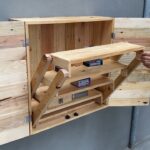I. Understanding CNC and Laser Upcycling Machines: An Overview
II. Key Differences Between CNC and Laser Machines for Upcycling
III. Choosing the Right Machine for Your Eco-Friendly Projects
Understanding CNC and Laser Upcycling Machines: An Overview
Welcome to the fascinating world of upcycling! If you’re interested in turning old materials into something new and fabulous, you’ve likely come across CNC and laser upcycling machines. But what exactly are these machines, and how do they work? Let’s dive in!
What is CNC?
CNC stands for Computer Numerical Control. It’s a technology that uses computers to control machine tools. Think of it as a wizard behind the curtain, guiding machines to create precise cuts and shapes. CNC machines can work with various materials, including wood, metal, and plastics. They follow programmed instructions that dictate every movement, ensuring high accuracy.
What is Laser Upcycling?
On the other hand, laser upcycling machines harness the power of lasers to cut, engrave, or etch materials. A laser beam focuses intense energy on a specific point, allowing it to slice through materials with incredible precision. This method is particularly popular for delicate designs or intricate patterns that would be challenging to achieve with traditional tools.
How Do They Work?
Both CNC and laser machines are user-friendly, especially with the advancements in software. After you design your project on a computer using CAD (Computer-Aided Design) software, you send this design to the machine. Here’s how each works:
- CNC Machines: The CNC machine translates your design into movements, adjusting the tool path accordingly. Whether it’s drilling, milling, or routing, the machine takes care of the intricate details—perfect for larger projects requiring multiple cuts.
- Laser Machines: These machines use a focused laser beam to cut or engrave your chosen material. You can achieve detailed designs quickly, thanks to the speed and accuracy of the laser. Plus, there’s minimal waste, which is a significant perk for eco-conscious creators!
Applications in Upcycling
Both CNC and laser machines have found their niche in the upcycling realm. With the growing emphasis on sustainability, makers are increasingly using these machines to breathe new life into old materials. Here are some exciting applications:
- Furniture Restoration: Transforming discarded wood into stylish furniture pieces.
- Crafts and Decor: Creating custom home décor items from repurposed materials.
- Fashion: Designing unique wearable pieces by upcycling textiles.
A Final Thought
As we become more aware of our environmental footprint, the role of CNC and laser upcycling machines is becoming increasingly important. Not only do they empower creators to innovate and express their ideas, but they also contribute to a more sustainable future.
So whether you’re a seasoned maker or just starting your upcycling journey, understanding these machines is the first step toward transforming waste into wonderful creations. Get ready to unleash your creativity and make a positive impact on the planet!
Key Differences Between CNC and Laser Machines for Upcycling
When it comes to upcycling, you might have heard the terms CNC machines and laser machines tossed around quite a bit. Both are fantastic tools for transforming materials into something new and exciting, but they operate differently and are suited for different tasks. Let’s dive into the key differences between the two, so you can make an informed choice for your next eco-friendly project.
1. How They Work
At the heart of it, CNC (Computer Numerical Control) machines and laser machines operate on different principles:
– **CNC Machines**: These machines utilize a rotating tool to cut and shape materials. Imagine a drafting pencil that moves back and forth, cutting away at the material layer by layer. CNC machines can work with a variety of materials, including wood, metal, and plastic. They often use tools like routers or mills to carve out complex designs, making them perfect for detailed woodworking or intricate metalwork.
– **Laser Machines**: Laser machines, on the other hand, use a focused beam of light to cut or engrave materials. The laser generates enough heat to melt or vaporize the material along a precise path. This method is incredibly accurate and can produce clean, fine details. You’ll often see laser machines used for engraving designs on wood, cutting intricate patterns in acrylic, or even etching glass.
2. Precision and Detail
When it comes to precision, both machines shine in their own right, but for different reasons:
– **CNC Machines**: These are champions when it comes to working with thicker materials or creating 3D shapes. They excel in producing parts that require a lot of milling and have depth. If you’re looking to create something substantial, like furniture or sculptures, a CNC machine might be your best bet.
– **Laser Machines**: If your project requires fine detail, such as delicate engravings or intricate cutouts, laser machines are the way to go. They can handle complex designs with ease and leave a clean finish. Plus, since they can work with thinner materials, they are fantastic for projects like jewelry making or decorative art pieces.
3. Material Compatibility
Another significant difference lies in the types of materials each machine can handle:
– **CNC Machines**: These machines are versatile when it comes to material compatibility. They can work with hard materials like metals, making them suitable for mechanical parts or industrial applications. They can also carve through wood, making them popular for furniture and cabinetry.
– **Laser Machines**: Laser cutters are ideal for materials such as wood, acrylic, cardboard, and even some fabrics. However, they may struggle with thicker metals and can be limited in their capacity for certain heavy-duty materials. If your project involves a lot of intricate patterns in wood or plastic, a laser might be your go-to.
4. Setup and Learning Curve
Finally, let’s talk about the ease of use:
– **CNC Machines**: Setting up a CNC machine can be a bit more complex. You often need to learn about tool changes, feeds, and speeds, which may be intimidating for beginners. However, with patience and practice, it can be very rewarding.
– **Laser Machines**: Laser machines are generally more user-friendly. Many models come with software that simplifies the design process, and the setup is usually straightforward. This makes them accessible for hobbyists and those looking to dip their toes into creative projects.
Conclusion
In summary, while both CNC and laser machines offer incredible opportunities for upcycling, each has its unique strengths and applications. Understanding these differences can help you choose the right tool for your specific needs. Whether you want to carve out a beautiful piece of furniture or create detailed art, there’s a machine out there that’s perfect for your eco-friendly project!
Choosing the Right Machine for Your Eco-Friendly Projects
When it comes to embarking on eco-friendly projects, selecting the right upcycling machine can feel like a daunting task. With so many options available, how do you choose between a CNC and a laser machine? Let’s break it down in a way that makes it easier for you to find the perfect fit for your sustainable crafting endeavors!
1. Assess Your Project Needs
Before you rush out to purchase a machine, take a moment to consider what kinds of projects you want to tackle. Ask yourself:
- What materials will I be working with? (wood, acrylic, metal, etc.)
- What level of precision do I require for my designs?
- Am I looking to create intricate designs or larger, more functional pieces?
If your projects involve detailed designs, a **CNC machine** might be your best bet, as they are exceptional for intricate designs. On the other hand, if you’re all about cutting or engraving materials with precision, a **laser machine** could be the way to go.
2. Evaluate Your Budget
Let’s talk numbers! Setting a budget is essential, especially when it comes to upcycling machinery. Here are some points to consider:
- CNC machines tend to be more expensive due to their complexity and capabilities.
- Laser machines can range widely in price, but entry-level options can be more affordable.
- Don’t forget about maintenance costs and the price of supplies!
If you’re just starting out, consider investing in an entry-level machine that meets your basic needs. You can always upgrade later as your projects evolve and your skills improve.
3. Space Considerations
Let’s face it: not everyone has a spacious workshop to house their new upcycling machine. Space is a significant factor to think about:
- CNC machines often require more room due to their larger footprint and the need for safety equipment.
- Laser machines can be more compact, making them suitable for home use or smaller workspaces.
Take measurements of your available space and ensure that your chosen machine fits comfortably while allowing for adequate ventilation and safety precautions!
4. Learn About Your Options
Before making a final decision, invest some time in research. Look into:
- Online forums and communities where fellow crafters share their experiences and tips.
- Product reviews to understand the strengths and weaknesses of the machines you’re considering.
- Local workshops or classes that might allow you to try out different machines before committing.
Knowledge is power! The more you learn about the machines out there, the better equipped you’ll be to make a confident choice.
5. Start Small and Experiment
Once you’ve chosen your machine, dive into your projects with enthusiasm! Remember, upcycling is all about creativity. Don’t hesitate to experiment with different materials and techniques. Here’s a pro tip: start with simple projects to get comfortable with your new machine before moving on to more complex designs.
In the end, choosing the right machine for your eco-friendly projects is about finding a tool that aligns with your creative vision, budget, and workspace. With a little thought and research, you’ll be well on your way to crafting beautiful, sustainable pieces that make a positive impact on the environment!










Comments